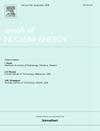垂直螺旋盘管中水饱和沸腾的实验研究
IF 1.9
3区 工程技术
Q1 NUCLEAR SCIENCE & TECHNOLOGY
引用次数: 0
摘要
螺旋盘管用于高温气冷堆(HTGR)一次性蒸汽发生器(OTSG)。然而,由于离心力和二次流,这些管道内的传热特性可能与直管不同。清楚地了解螺旋盘管内部的传热对OTSG的设计和运行至关重要。在本研究中,我们对大曲率比(δ = 0.109)的螺旋盘管内的饱和流沸腾进行了实验研究。实验参数涵盖的范围很广。系统压力为3.5 ~ 7mpa,质量通量为300 ~ 1100 kg/(m2·s),热流通量为50 ~ 600kw /m2。结果表明:内壁温度分布不均匀,内壁温度最高,内壁温度最低;增加热流密度可以提高饱和流沸腾换热系数。在低汽质条件下,换热系数不受质量通量变化的显著影响。然而,在较高的蒸汽质量下,增加质量通量可以改善传热。系统压力的增加提高了低蒸汽质量时的传热系数,但降低了高蒸汽质量时的传热系数。对饱和流动沸腾的六种关联进行了评估,其中最初为直管开发的gungore - winterton关联能够准确预测螺旋盘管的传热系数(MAPE为12.72%,RMS为15.36%)。这表明,即使在曲率比较大的螺旋盘管中,饱和流沸腾换热系数与直管相比也没有显著差异。本文章由计算机程序翻译,如有差异,请以英文原文为准。
Experimental investigation of saturated flow boiling of water in vertical helically coiled tubes
Helically coiled tubes are used in the High Temperature Gas-cooled Reactor (HTGR) Once Through Steam Generator (OTSG). However, due to centrifugal forces and secondary flows, heat transfer characteristics inside these tubes may differ from that in straight tubes. A clear understanding of the heat transfer inside helically coiled tubes is essential for the design and operation of the OTSG. In this study, we experimentally investigated saturated flow boiling in helically coiled tubes with a large curvature ratio (δ = 0.109). The experimental parameters cover a broad range. The system pressure is from 3.5 to 7 MPa, mass flux is from 300 to 1100 kg/(m2·s) and heat flux is from 50 to 600 kW/m2. Results show that the inner wall temperature distribution is uneven, with the highest temperature on the inner side and the lowest on the outer side. Increasing heat flux enhances the saturated flow boiling heat transfer coefficient. At low steam quality, the heat transfer coefficient is not significantly affected by mass flux variations. However, at higher steam quality, increasing mass flux improves heat transfer. An increase in system pressure enhances the heat transfer coefficient at lower steam qualities but reduces it at higher steam qualities. Six correlations for the saturated flow boiling were evaluated, with the Gungor-Winterton correlation originally developed for straight tubes showing accurate predictions for heat transfer coefficients in helically coiled tubes (MAPE is 12.72 %, RMS is15.36 %). This indicates that even in helically coiled tubes with a large curvature ratio, no significant difference is observed in the saturated flow boiling heat transfer coefficient compared to straight tubes.
求助全文
通过发布文献求助,成功后即可免费获取论文全文。
去求助
来源期刊

Annals of Nuclear Energy
工程技术-核科学技术
CiteScore
4.30
自引率
21.10%
发文量
632
审稿时长
7.3 months
期刊介绍:
Annals of Nuclear Energy provides an international medium for the communication of original research, ideas and developments in all areas of the field of nuclear energy science and technology. Its scope embraces nuclear fuel reserves, fuel cycles and cost, materials, processing, system and component technology (fission only), design and optimization, direct conversion of nuclear energy sources, environmental control, reactor physics, heat transfer and fluid dynamics, structural analysis, fuel management, future developments, nuclear fuel and safety, nuclear aerosol, neutron physics, computer technology (both software and hardware), risk assessment, radioactive waste disposal and reactor thermal hydraulics. Papers submitted to Annals need to demonstrate a clear link to nuclear power generation/nuclear engineering. Papers which deal with pure nuclear physics, pure health physics, imaging, or attenuation and shielding properties of concretes and various geological materials are not within the scope of the journal. Also, papers that deal with policy or economics are not within the scope of the journal.
 求助内容:
求助内容: 应助结果提醒方式:
应助结果提醒方式:


